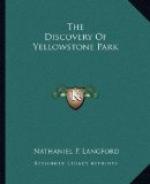I was the more disposed to credit his statement, because of what I had previously read in the report of Captain John Mullan, made to the war department. From my present examination of that report, which was made Feb. 14, 1863, and a copy of which I still have in my possession, I find that Captain Mullan says:
I learned from the Indians, and afterwards confirmed by my own explorations, the fact of the existence of an infinite number of hot springs at the headwaters of the Missouri, Columbia and Yellowstone rivers, and that hot geysers, similar to those of California, exist at the head of the Yellowstone.
Again he speaks of the isochimenal line (a line of even winter temperature), which he says reaches from Fort Laramie to the headwaters of the Yellowstone, at the hot spring and geysers of that stream, and continues thence to the Beaver Head valley, and he adds:
This is as true as it is strange, and shows unerringly that there exists in this zone an atmospheric river of heat, flowing through this region, varying in width from one to one hundred miles, according to the physical face of the country.
[Illustration: Very much yours D.G. Folsom]
As early as the year 1866 I first considered the possibility of organizing an expedition for the purpose of exploring the Upper Yellowstone to its source. The first move which I made looking to this end was in 1867 and the next in 1868; but these efforts ended in nothing more than a general discussion of the subject of an exploration, the most potent factor in the abandonment of the enterprise being the threatened outbreaks of the Indians in Gallatin valley.
The following year (1869) the project was again revived, and plans formed for an expedition; but again the hostility of the Indians prevented the accomplishment of our purpose of exploration. Hon. David E. Folsom was enrolled as one of the members of this expedition, and when it was found that no large party could be organized, Mr. Folsom and his partner, C.W. Cook, and Mr. Peterson (a helper on the Folsom ranch), in the face of the threatened dangers from Indians, visited the Grand Canon, the falls of the Yellowstone and Yellowstone lake, and then turned in a northwesterly direction, emerging into the Lower Geyser basin, where they found a geyser in action, the water of which, says Mr. Folsom in his record of the expedition, “came rushing up and shot into the air at least eighty feet, causing us to stampede for higher ground.”




